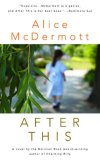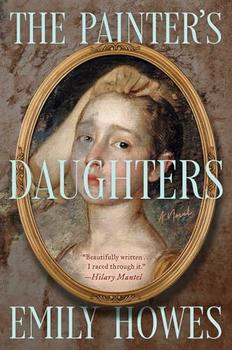Reading Guide Questions

Please be aware that this discussion guide will contain spoilers!
The questions and discussion topics that follow are designed to enhance your
reading of Alice McDermott's After This. We hope they will enrich your
experience as your book club explores this moving novel.Winner of the National
Book Award, Alice McDermott has captivated countless readers with her tender
portrayals of family life in America, from Irish-Catholic suburbia to the
beaches of Long Island and Manhattan's historic streets.
After This, her
sixth novel, takes us to the cultural transitions of the mid-twentieth
century—the span between World War II and Nixon, when a sexual revolution,
Vatican II, draft registration for the controversial Vietnam conflict, and other
headlines spelled upheaval for families across the nation.
Introduction
Bringing those cultural shifts vividly to life, McDermott introduces us to Mary
and John Keane, a middle-class couple raising four children as the country
arrives at historic crossroads. Michael and Annie test the boundaries of their
changing world, while the eldest and most cautious sibling, Jacob, is sent to
war. Young Clare proves to possess a worldliness that belies her innocent
sensitivity. Together, the Keanes navigate the clashes of a traditional life and
modern freedom. Portrayed by McDermott through a serious of seamless,
beautifully wrought vignettes, their story opens our hearts to new
understandings of fate and everyday mercy.
- Alice McDermott's writing style has been widely praised for its
evocative imagery and powerful use of understatement. How were you affected
by the quiet lines that told you of John's future death (pages 130–131) or
of Jacob's fate in Vietnam (page 199)? What everyday images best capture the
most emotional events of your life?
- The initial scenes in After This tell us that Mary dated her
brother's friend George before she married John, and that she had given in
to Mike Shea's advances at a party. How did these facts shape your
understanding of her as you read about her life? Before she was married,
what did Mary seem to believe her destiny was?
- Discuss the memory of the "baby grand." How would you describe Mary and
John's life at that point, before the birth of their children? What was Mary
discovering about her husband when they were newlyweds? How did the death of
his brother shape John?
- What was foreshadowed by the scene at Jones Beach, not only in terms of
Vietnam, but in the temperaments of the children and the dynamics of the
family as a whole?
- What do Mary and John teach their children about the role of religion,
from the time they are young (saying an "Angel of God" during the 1960
hurricane) to the novel's closing scene? How does the children's
relationship to the church differ from their parents' relationship to it?
Did you adopt your parents' views on religion?
- Does the typical twenty-first-century American family resemble the
Keanes? Has the very definition of family shifted? What would the future
likely hold for Clare and Gregory?
- Mary became an adult when images of the ideal woman were almost always
domestic; she was even expected to cook dinner for her father and brother
each night, regardless of her plans for the evening. Her daughters would
have access to far more career options, as well as birth control and legal
abortions. Was the generation gap of the 1960s more significant than for
other generations of mothers and daughters? How did gender roles for men
shift during this time period? Did John's sons fulfill his expectations?
- How does the novel's setting affect the storyline? How was the turmoil
depicted in After This playing out elsewhere in the country? What is
distinctive about the locales so frequently featured in Alice McDermott's
fiction?
- Discuss the other outcomes described in the novel, such as Mr.
Persichetti's addicted son, or Pauline's spinsterhood (is she a difficult
person because she never married, or did she never marry because she's such
a difficult person?). What determines which course a life will take?
- Part III (page 79) begins with John's thoughts: "Man is immortal, or he
is not. And if he is, there's the whole question of whom you pray to.
If he's not, then prayer is wishful thinking. You either pray to the dead or
you don't." What is the greater quandary he wrestles with in this passage?
Do you think he ever resolves it?
- How did war and politics shape family life in the 1960s and early 1970s?
Has the impact of one on the other changed in contemporary America?
- As Annie bluffs her way through the Edith Wharton dialogue and embarks
on a relationship with an English lover, how does she seem to view her past?
How is she defining herself in those scenes? What enabled her to have an
identity that seems so different from her mother's?
- The friendship between Pauline and Mary is often referred to as
obligatory, a fulfillment of the commandment to "feed my lambs." Is this
friendship by contemporary standards? Is that sense of obligation waning,
and if so, what are the consequences for communities in general? Does Mary
seem to have any friendships like Annie and Susan's?
- How would you have responded to Sister Lucy's story (page 214) if you
had been one of her students?
- What was your reaction to the novel's closing conversation? What is the
impact of the priest's question about distinguishing God-given gifts from an
accomplishment attained only through strenuous effort? How does that scene
speak to the Keane family's destiny?
- What comes to mind when you consider the novel's title? What aftermaths
resonated the most with your own life story?
- In what ways does After This complement and amplify the themes of
McDermott's previous fiction? What might the Keanes think of the other
families she has created?
Page numbers refer to the hardcover USA edition, and may vary in other editions.
Suggested Reading
Moral Disorder by Margaret Atwood;
Baker Towers by Jennifer Haigh;
When Madeline Was Young by Jane Hamilton;
L'America by Martha McPhee;
The Last of Her Kind by Sigrid Nunez.
Unless otherwise stated, this discussion guide is reprinted with the permission of The Dial Press.
Any page references refer to a USA edition of the book, usually the trade paperback version, and may vary in other editions.

 Book Reviewed by:
Book Reviewed by:


